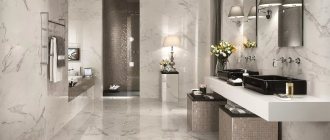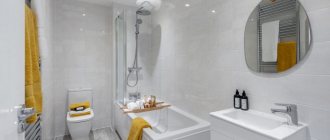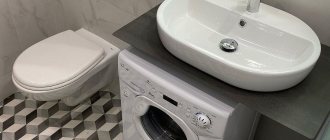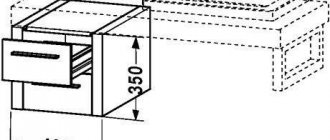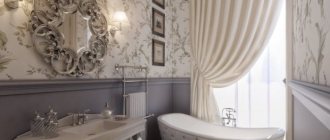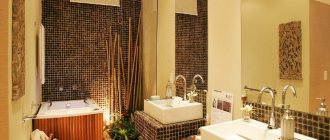Ceramic tiles have always been considered the most practical material for finishing walls in a bathroom. But what to do if the budget does not allow for finishing the entire surface with this material? Refuse to repair? Or would you prefer more budget-friendly finishing options?
Of course, budget savings will also affect the durability of the repair. Therefore, we recommend choosing the “golden mean”: combining ceramic tiles in the bathroom with painting. Let's look at different options for combining these two materials and debunk the myths associated with painted walls in the bathroom.
Tiles in wet areas
This technique is appropriate if you want to make the environment more diverse and dynamic by protecting all the “weak” points of connection between sanitary devices (sink, bathtub, toilet) with the walls.
A bathroom with tiles in wet areas performs its main function, protecting surfaces from moisture and also giving them texture. In this case, the paint occupies most of the walls, visually unifying the interior. Water-based, latex and acrylic compositions are suitable for the bathroom.
Latex paint: characteristics
Latex can be natural or synthetic. Latex paints are made on the basis of natural latex - the juice of rubber plants. These particles are dissolved in water and do not form rigid bonds. As the water dries, an elastic, waterproof film forms on the surface. Its advantages are:
- Easy to apply.
- Dries quickly.
- Almost odorless.
- Abrasion resistant coating.
- Durable.
- Easy to clean.
- Can be tinted with various pigments.
The paint is applied with a roller or brush. For normal staining, it is advisable to apply 2 layers. To reduce paint consumption, it is advisable to pre-prime the surface.
Some brands of latex bathroom paint
There are also disadvantages:
- In order for the paint to look good, the walls need to be perfectly prepared - a thin film will highlight all the imperfections.
- Not suitable for unheated rooms. Lower temperature threshold +10°C.
- Before painting, the walls must be treated with antifungal compounds.
- High price.
Mostly, latex bathroom paint is not purchased because of the high price. If you look at the price per liter, it is. But we must take into account that the consumption of this paint is very small, so you will need to buy a small amount. The second point that must be taken into account is that the painted surface does not change its appearance for a long time. Literally nothing has happened to her for years. So “expensive” is relative.
One more thing: if you want to have a “silky” shine on your bathroom walls, you need latex paint. No other product gives this effect.
Only the shower area is tiled
This option is the most economical, since only the area above the bathtub or the surface around the shower is tiled. If you want to create an accent, choose tiles that contrast with the walls, and if you dream of a calm, enveloping interior, purchase materials that are as close in shade as possible.
Try not to skimp on paint and buy the composition specifically for the bathroom - this information is indicated on the packaging.
Features of the choice of materials
Today, the use of several finishing materials has already become a trend. Different textures, shades and properties will undoubtedly create dynamics in the room and allow for zoning, and in some cases, visually change the proportions of the room.
Bathroom paint
The bathroom is a room with high humidity and sudden temperature changes. It is important to choose the right coloring composition: the paint must be wear-resistant, moisture-resistant, and resistant to fungus and mold. Manufacturers often mention for which premises this or that paint is intended. On the jars you can see “For bathrooms”, “For kitchens and bathrooms”, “For wet rooms”, etc. Most often these are paints based on acrylic, silicone or latex.
But you shouldn’t skimp on paint, even if you think that the painted surface will look budget-friendly regardless of the cost of the paint. After all, there is such a thing as “paint hiding power”. Cheaper coatings will need to be applied in several layers, and in this case you will need much more paint. Therefore, when painting small surfaces, give preference to high-quality, expensive compounds.
Selecting tiles
For bathroom walls, you can choose both budget ceramic tiles and modern types of porcelain tiles. Moreover, combining this type of coating with paint is quite easy. But it is better to lay thicker porcelain stoneware on the floor.
As for the size of the slabs, in small rooms either medium-sized elements or porcelain stoneware slabs with no visible seams will look good - this will create the effect of space integrity. But you shouldn’t make it smaller - for small rooms such a choice is hardly appropriate. Large slabs with noticeable seams will look ridiculous and will make a cramped room even smaller.
If, along with painting and tiling, you are also planning accent inserts, then mosaics or narrow metal moldings would be an excellent option for this purpose.
Additional materials
In addition to traditional tiles and paint combined in the bathroom, you can also use more expensive and “fashionable” materials as accents:
- Tree. One of the trends of the last few years is the combination of gray porcelain tiles with wood - they frame niches, use them as shelves and a countertop under the sink, and add small decorative elements (soap dishes, glasses for toothbrushes). Of course, many of us do not associate this material with high humidity, so wooden surfaces used in bathroom decoration require special treatment.
- Stone slabs. Decorating walls with cuts of natural stones is prestigious and elegant. No porcelain stoneware will replicate the pattern of natural stone. Of course, this pleasure is not cheap, so you can use such material only on one accent wall.
- Glass and mirrors. The mirror does not necessarily have to be wall-mounted and with cabinets - it can be mounted between the tiles (taking into account the height of the tiles and the mirror), for example above the sink, to highlight recesses and niches. Glass will add airiness to any small room - use it instead of a shower curtain. In addition, designers sometimes resort to another technique during a major renovation: the bathroom wall bordering the living room can be made of glass blocks - this way natural light will penetrate into the windowless room.
- Decorative plaster. A universal finishing material that can be used to imitate any surface: from natural stone or wood to brutal cement. For bathrooms, moisture-resistant plaster is preferably selected, and for greater protection it is coated with varnish.
- Mosaic. Makes an excellent accent material. And if it is a hand-laid mosaic panel, then the bathroom will really acquire an expensive and unique design.
The area under the ceiling has been painted
For some, this technique resembles the “Soviet” version of bathroom cladding, but it still does not lose its relevance. The implementation of the idea is found in both expensive classical style and luxurious art deco.
Looks great with high ceilings and allows you to save on the amount of tiles. It is also appropriate for low ceilings, when there is about 40 cm of free space on top - the painted area looks like a frame and is complemented by moldings.
Bathroom: painting the walls or tiling? Debunking 7 Main Misconceptions
Is it worth continuing to tile all the walls in the bathrooms with ceramic tiles? Let's try to debunk the main myths about painting bathroom walls and listen to expert advice.
No matter how much leading designers recommend painting walls in bathrooms, we continue to diligently glue even rows of ceramic tiles. And let it be “like everyone else,” but it will be reliable. We ourselves don’t really remember what exactly reliability consists of, but old habits are hard to change. But our ideas about painted walls are often just misconceptions.
Myth 1 – “Painted walls are boring”
Yes, many still remember what the walls looked like in some Soviet apartments: painted with green or dirty beige oil paint, even then they were associated with poverty and despondency. But the situation has long since changed. Designers use painting bathroom walls in interiors of many styles: they combine paint of restrained tones with stucco and traditional tiles for art deco, paint the walls in pastel colors for a light vintage and Provence feel, use a cheerful palette to recreate the era of the 50s and a contrasting bright one for style pop Art.
Painting allows you to use artistic painting and apply ornaments to the walls; if desired, the bathroom walls can be painted in different colors or applied with a striped, checkered or diamond pattern. And as soon as you get tired of all this, in just one day you can repaint the walls again - which cannot be compared with a complex renovation where tiles were used!
Myth 2 - “In the bathroom, painted walls are afraid of water”
Of course, the absorbency of ceramic tiles is much lower than that of paint, but we are not going to pour water directly on the wall. Glass and tiled aprons around the sink and bathtub have not been canceled, and if your neighbors flood you one day, the renovation will still suffer, and no tile will save you. There are also those who still believe that water-based paint will simply be washed off with water. In fact, acrylic and latex dry irreversibly, that is, it will no longer be possible to dissolve them with water after drying. According to their characteristics, acrylic and latex paints with special additives for wet rooms are ideal for ceilings and walls in bathrooms.
Myth 3 – “Painting bathroom walls is bad for your health”
Modern house paints are water-based, which is completely safe: they simply do not contain solvents that could be harmful to humans. Paints from reputable manufacturers have hygienic permits and certificates confirming the safety of their use, and it is your responsibility to request them from the seller when purchasing. In addition, special paints are produced for bathrooms and other rooms with high humidity that do not deteriorate and do not emit harmful fumes at high temperatures.
Myth 4 - “Painted walls will immediately become covered with mold”
In any room where there is moisture and there is no normal ventilation, there is a really high probability of mold and other fungi appearing. Moreover, mold feels great even in a room completely covered with tiles; it is simply located under it - which is less noticeable, but no less harmful. Meanwhile, paints labeled “bathroom” often contain special components that prevent the development of harmful microorganisms; their content per square meter can be further increased by applying two or three layers of bathroom paint.
Myth 5 – “The paint on the bathroom walls always cracks”
Cracks on painted walls are a common phenomenon not only in bathrooms. And paint, as a rule, has nothing to do with it: cracks form on poorly prepared walls. The surface of the wall must be well leveled, and the plaster must be completely dry; it is also unacceptable to skip the priming stage. On a properly prepared base and using high-quality paint, cracks will not appear.
Myth 6 - “After painting the walls in the bathroom, a white coating appears on them”
White deposits are calcareous traces of water from splashes and condensation. Owners of bathtubs lined with dark tiles are constantly “fighting” with such a coating, while those with light tiles simply do not notice it. Responsible paint manufacturers have thought about this too: quality bathroom paints prevent condensation and are deliberately produced in white and pastel colors.
Myth 7 – “Painting a bathroom is too much hassle”
In fact, you only need to spend one time on high-quality plaster, primer and paint, as well as on paying for the work of professionals, who are better off inviting for high-quality preparation of the base. And then - repaint the walls to your taste at least once every three years, at least once a month, and do it yourself, armed with a can of paint and an ordinary roller!
Expert comments:
Valery Ermakov, chief technologist-consultant of TM Belinka 1. To protect walls and ceilings in wet rooms (bathrooms, kitchens, laundries, drying rooms, swimming pools, etc.), special paints are used, usually water-based acrylic. High-quality bathroom paint should prevent the formation of fungus, because there is a high probability of its occurrence due to the increased concentration of water vapor. Such paint should create a vapor-permeable coating, prevent the formation of condensation on the surface, and be easy and opaque to apply. 2. In bathrooms, it is more practical to use paints in light shades, and minor imperfections in the wall will help hide textured plasters (in this case, choose plaster marked “for bathrooms”, and do not forget that the textured basis will increase paint consumption). When preparing the base, be sure to make sure that there is no fungal infection, otherwise use an anti-mold product according to the instructions. 3. The role of enhanced ventilation in wet areas cannot be underestimated. Here it is necessary to install forced ventilation in combination with constant ventilation of the room. It is advisable to protect the areas around the shower cabin, bathtub and washbasin from constant ingress of water, for example, by tiling them or covering them with tempered glass; in other places, painting the walls is absolutely justified.
We thank the specialist for his assistance in preparing the article.
(photo: photos.hgtv.com, pinterest.com) Add to bookmarks
Tiles as accents
This approach helps to adjust the proportions of the room by highlighting certain areas - for example, a niche, the wall around the sink and mirror, part of the shower area.
In the interior shown in the photo, colorful tiles and matching gray paint are used: bright accents set the mood of the bathroom, increase its decorativeness and highlight what is not supposed to attract attention.
Bathroom tile design
Manufacturers' offer includes many collections available in many formats, so finding bathroom tiles with a fashionable design will not be difficult. Before purchasing, you should check with the manufacturer what installation method they offer.
You can choose from several tile installation options: standard, 1/2 or 1/3 offset, square tiles laid in a diamond pattern, or rectangular tiles laid in a herringbone pattern.
Fashionable hexagonal tiles deserve special attention. This popular pattern looks good in any interior, both on the wall and on the floor.
Which tile patterns to choose for a small bathroom? As mentioned earlier, in small areas you should not combine too many patterns and textures. It is better to focus on delicate shades and patterns.
- Rectified tiles in the 60x60 cm format look good on the floor, and thanks to the minimal amount of grout in the interior, it will be possible to create a uniform, easy-to-clean surface.
- Patterns on the floor and walls give the interior a special character. Geometric motifs arranged in a certain rhythm add depth, and floral decorations on the tiles create a pleasant and romantic atmosphere in the interior.
In minimalistic and monochrome interiors, spot elements of bright colors are ideally complemented: contrasting letters, decors, LED lighting, accessories.
- Moreover, the original color of fashionable bathroom tiles on one wall or part of the floor can not only become the most important decoration of the bathroom, but also optically correct its proportions. Mosaics, tiles with oriental and Moroccan patterns are accents on a neutral background.
- However, it is worth using them in moderation, because too saturated colors can overstimulate and “crush”.
- When deciding on decorative finishing of walls and floors, you need to show moderation and consistency in the choice of equipment and accessories.
Against the background of decorative tiles, a white washbasin with simple classic shapes will look better than an original washbasin. Its minimalistic design will not compete for attention with a bold pattern on the wall.
Also, an original finishing effect can be achieved using structural tiles. Several large format tiles with attractive surfaces and clever lighting create a stunning visual effect. You can achieve better results by using a trendy tile layout in the bathroom.
Choosing trendy tiles and planning a wall and floor layout are certainly tough decisions, but it's worth spending some time on when creating your dream bathroom.
Half of the bathroom painted
This traditional technique involves dividing the wall into two sections. With this approach, the decor looks strict and laconic, so it allows you to play with the decor. The proportions can be varied by painting a smaller or larger part of the walls.
If laid evenly, the joint need not be processed. An option is available with a frame in the form of narrow tiles or mosaics, as well as a ceramic shaped edge, appropriate in a classic style.
Alkyd enamel
This type of paint can be used not only for the bathroom, but also for exterior or interior work. The main disadvantage is the strong odor during application and drying, since the solvent is white spirit. Domestic alkyd enamels are often toxic, so you need to work in a ventilated area and, better yet, wear a gas mask. The composition may also include a filler (very finely ground stone chips or sand), a pigment to give color, and there may be antibacterial or antiseptic additives.
Advantages of alkyd enamels:
- High film strength.
- Resistance to aggressive environments.
- Short drying time.
- Low price.
- Good adhesion.
- Does not turn yellow or crack.
- Wide temperature range of application.
When choosing, it is better to opt for imported products. The price differs significantly, but so does the quality. The most important thing is that imported alkyd enamel smells much less and is definitely non-toxic.
Alkyd enamel - not bad for everyone, but has a strong “smell”
The disadvantages have mostly already been stated: odor and toxicity, but there are also some unpleasant aspects:
- The surface coated with alkyd paint does not allow air and steam to pass through, so the ventilation system in the bathroom must be effective.
- To prevent fungus from appearing in the bathroom, preliminary protection of the base is necessary.
Alkyd enamel has two forms of release: standard - in cans, and also in aerosols. Aerosols are more versatile - they can be applied to any surface, they are also easier to paint hard-to-reach places, but they are more expensive.
Only wall painted
The combination is ideal for small bathrooms and also allows you to save money. Typically, a painted wall does not come into contact with plumbing fixtures, or at most with a heated towel rail.
The color of the paint should echo the shade of the tile, its elements, or even the color of the grout: this helps bring the design together.
Since both tiles and paint are resistant to moisture, and the range of materials knows no bounds, the combination is considered ideal for the bathroom. Thanks to this, the design is not only original, but also economical.
Painted walls in the bathroom and toilet: let's talk about design
Painted walls are relevant for bathrooms designed in a retro style. This is art deco in the spirit of the twenties and thirties, and bright pop art of the middle of the last century, and “cheerful” vintage a la my mother’s youth.
Art Deco is characterized by the use of neutral or restrained color paint with a smoky tint: gray, gray-green, gray-violet, etc.
Retro style from the middle of the last century and later periods, on the contrary, gravitates towards a cheerful palette. However, the colors here are usually not bright, but rather pastel, light in spring.
Painted walls in the bathroom and toilet provide an excellent opportunity to apply drawings and artistic painting. These can be simple ornaments made independently using a stencil, or complex plot compositions created by the artist.
If desired, a bathroom or toilet can be painted not in one, but in several colors, combining them in stripes, zigzag, diamond patterns or panel type.
As you can see, paint on the walls is anything but boring. The proximity to the tiles also adds a significant amount of variety. For the mentioned Art Deco style, the combination of painted surfaces with hog tiles is typical. In a retro bathroom, you can combine paint and patchwork tiles.
In general, the paint is in harmony with any tile - be it vintage or ultra-modern. The options for their interaction are also very diverse.
When it comes to paint color, the rules are simple. The brighter and more spacious the room, the darker the walls can be. And vice versa - for a very small bathroom without a window, light paint is preferable. Of course, you can ignore these postulates and paint your compact bathroom any color you like, even black. This is your right, but you should be aware of the possible consequences - such as darkness, gloominess, coldness, the feeling of walls being drawn closer together.
Oil paint
Oil paints are made from drying oil or synthetic oils. Compositions based on drying oil are considered the best, but they are more expensive. Minerals ground into flour are added to the base, which are responsible for the color of the coating. These particles are insoluble, and since they are heavier than oils, they settle to the bottom. Therefore, before use and during operation, the paint must be mixed. Advantages of this type of paint:
- Low price.
- Waterproof coating.
- Fits well on a properly prepared surface.
- Good adhesion.
- Can be used to color metal and wood.
If you need inexpensive paint for your bathroom, this is your option. One has only to take into account that the service life of such coatings is very short: bubbles quickly form in places of direct contact with water, the paint begins to crack and peel.
Oil paints are the cheapest, but not the best option.
Disadvantages of oil paint:
- The composition contains organic solvents, so the smell is strong and persistent until drying.
- Vapors may be toxic.
- Fewer colors due to the use of only mineral pigments.
- Long drying time - at least 6 hours. Throughout this time, the paint “smells.”
- After some time, the paint changes color (a yellow tint is added). It fades quickly in the sun.
- In humid areas it cracks and peels.
The combination of these qualities leads to the fact that oil paints are used less and less. Even the low price does not help, so you have to update the coating almost every year. In this case, the normal appearance is maintained for a few months. In general, this is the most unsuccessful paint for the bathroom of all those described.
Preparing for coloring
High-quality preparation of the base largely determines how the new coating will look. Therefore, before staining, perform the following operations:
- They take all things out of the bathroom, dismantle furniture, mirrors, wall sconces (if any).
A simple way to refresh your interior Source squarespace-cdn.com
- The tiled surface is cleaned of dirt with any detergent. If there is mold, it is removed and additional disinfection treatment is carried out.
- Glossy tiles are sanded to make them matte and rough.
- If you want to get a completely flat base, you need to putty the seams, since they are usually slightly recessed relative to the cladding.
- If necessary, restoration is carried out: scratches and chips are puttied, damaged areas on the seams are also rubbed with putty. Allow the mixture to dry completely.
- The prepared surface is degreased; White spirit or turpentine will do.
- Plumbing fixtures and stationary accessories are protected with polyethylene and masking tape.
- The tiles are primed using a brush or roller. The main component of the primer should be the same as the base paint.
Applying the first layer of primer Source stroyipoy.ru
Matte or glossy surface
In the photo with various ideas for bathroom design for painting you can find glossy or matte finishes. The choice largely depends on the style of the interior or the size of the room.
Gloss is well suited for modern interior styles; this coating is especially impressive in hi-tech or minimalism. Shiny surfaces are also appropriate in small spaces, making the space brighter and wider. And if you add mirrors and distribute the light correctly, the effect will only intensify. Gloss makes stains, stains, and dust easier to see; such a bathroom will require more careful maintenance.
Matte walls are often chosen for the design of spacious rooms. Such decor looks more relaxed, visually reducing the dimensions, making the interior more comfortable. Matte paint can hide minor defects that are clearly visible in gloss. This design is more appropriate for classics, Provence, eco-style, Mediterranean style, etc.
Tools and auxiliary materials
High-quality repairs are impossible without a minimum set of tools and equipment. In addition to a can of paint, you need to stock up on the following things:
- A set of brushes of different sizes and hardness for painting corners and hard-to-reach places. Airbrush, spray gun - depending on ability to use.
- Palette (optional) to obtain the desired shades.
- Roller with replaceable blocks; paint tray of suitable size.
- Masking tape to protect surfaces bordering the painted area.
- Polyethylene or paper to protect everything that needs to be protected: floors, plumbing, furniture.
- Sandpaper (or sander) to roughen up glossy tiles.
Stencil ornament in a modern style Source pinimg.com
- If you plan to decorate with an ornament, you will need stencils or decorative stamps, as well as small brushes and sponges for applying pigment.
- Means of protection. A respirator and gloves are especially useful if the composition has a pungent odor.
- Additionally, the following materials are needed:
- Grout. It will help prepare the seams for painting.
- Priming. Acrylic or any other primer with high adhesion (for smooth surfaces) is suitable. It will make the tile rough, making it easier to apply paint.
- Varnish. Needed if you are going to additionally protect the paint layer.
- Solvent. It will be needed to wipe off paint that accidentally gets outside the tiles.
What problems does painting tiles solve?
Tile finishing is a practical and long-term solution, but even such a surface needs to be refreshed from time to time. Owners decide to paint for the following reasons:
- The method allows you to easily and quickly update a boring or outdated design. At the same time, the surface is restored: scratches, chips and small cracks are masked.
- The method requires small financial investments. All you need is to purchase paints and varnishes and the simplest tools.
- Completion times and labor costs will also be minimal. Dismantling of plumbing is not necessary; It is enough to protect the bathtub, sink, taps, and coils with polyethylene.
- Variety of designs. You can choose any shade and complement it with a pattern made using a stencil.
Using a stencil in floor decoration Source britishceramictile.com
Video:
Comments (3)
- Svetlana May 22, 2022 at 04:03 pm
What paint do you like?
Answer
- Natalya May 27, 2022 at 04:50 pm
I painted a bathtub a year ago with dulux paint and was very pleased. The paint is lump-free and dries quickly. Besides, it can also be washed, it’s totally cool.
Answer
- Evdokia December 12, 2022 at 7:56 am
thanks for the advice
